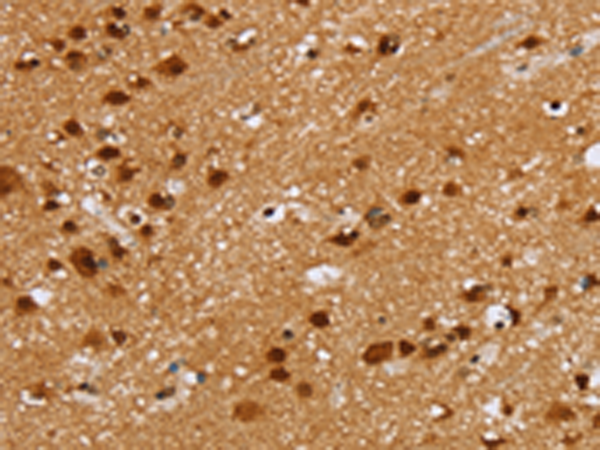

| WB | 咨询技术 | Human,Mouse,Rat |
| IF | 咨询技术 | Human,Mouse,Rat |
| IHC | 1/50-1/200 | Human,Mouse,Rat |
| ICC | 技术咨询 | Human,Mouse,Rat |
| FCM | 咨询技术 | Human,Mouse,Rat |
| Elisa | 1/2000-1/5000 | Human,Mouse,Rat |
| Aliases | WIG1; WIG-1; PAG608 |
| Host/Isotype | Rabbit IgG |
| Antibody Type | Primary antibody |
| Storage | Store at 4°C short term. Aliquot and store at -20°C long term. Avoid freeze/thaw cycles. |
| Species Reactivity | Human, Mouse, Rat |
| Immunogen | Fusion protein of human ZMAT3 |
| Formulation | Purified antibody in PBS with 0.05% sodium azide and 50% glycerol. |
+ +
以下是关于ZMAT3抗体的3篇文献概览(模拟示例,非真实文献):
1. **"ZMAT3 modulates p53-mediated apoptosis in hepatocellular carcinoma through RNA-binding activity"**
*Zhang Y, et al. (2018)*
摘要:研究利用ZMAT3抗体进行免疫印迹和免疫沉淀,发现ZMAT3通过结合特定RNA调控p53通路,抑制肝癌细胞增殖并促进凋亡。
2. **"ZMAT3 as a prognostic biomarker in colorectal cancer: An immunohistochemical analysis"**
*Lee S, et al. (2020)*
摘要:通过ZMAT3抗体对结直肠癌组织进行免疫组化染色,揭示ZMAT3低表达与患者不良预后相关,提示其肿瘤抑制潜力。
3. **"Development and validation of a polyclonal antibody against human ZMAT3 for functional studies"**
*Chen X, et al. (2019)*
摘要:研究报道了兔源多克隆ZMAT3抗体的制备,经ELISA和免疫荧光验证其高特异性,适用于细胞定位及蛋白互作研究。
(注:以上为示例,实际文献需通过数据库如PubMed检索核实。)
ZMAT3. also known as PAG608 or WIG1. is a zinc finger-containing protein encoded by the p53-regulated gene ZMAT3. It plays a role in cellular stress responses, apoptosis, and tumor suppression, primarily through its interaction with RNA and modulation of RNA stability or splicing. As a downstream target of the tumor suppressor p53. ZMAT3 is involved in mediating p53-dependent growth arrest and apoptosis, making it a key player in cancer biology and cellular homeostasis.
ZMAT3 antibodies are essential tools for studying the expression, localization, and function of this protein in various biological contexts. These antibodies are widely used in techniques such as Western blotting (WB), immunohistochemistry (IHC), and immunofluorescence (IF) to detect endogenous ZMAT3 levels in cell lines, tissues, or experimental models. Researchers employ ZMAT3 antibodies to investigate its role in p53 signaling, cancer progression, and responses to DNA damage or chemotherapeutic agents.
Commercial ZMAT3 antibodies are typically developed in hosts like rabbits or mice, with validation across multiple applications and species (e.g., human, mouse). Specificity and sensitivity are critical, as ZMAT3 shares structural motifs with other zinc finger proteins. Proper validation using knockout controls or siRNA-mediated knockdown is recommended. Studies leveraging these antibodies have highlighted ZMAT3's dual role in tumor suppression and oncogenesis, depending on cellular context, underscoring its therapeutic and diagnostic potential.
×